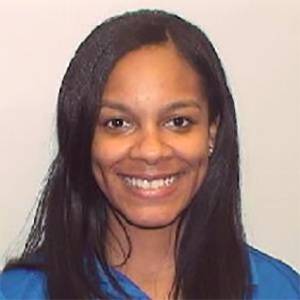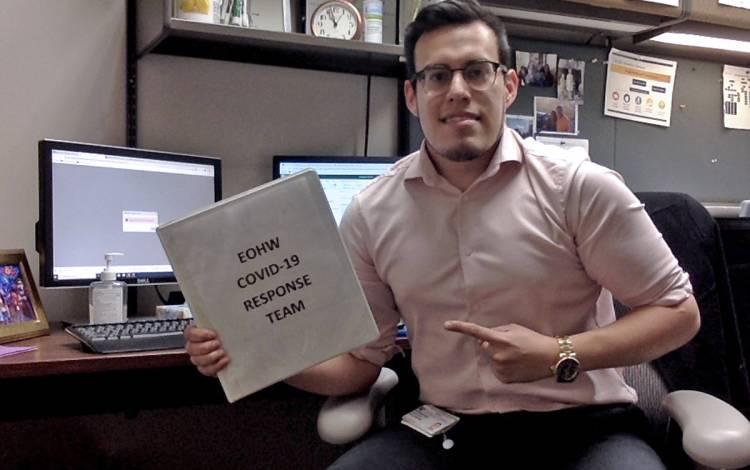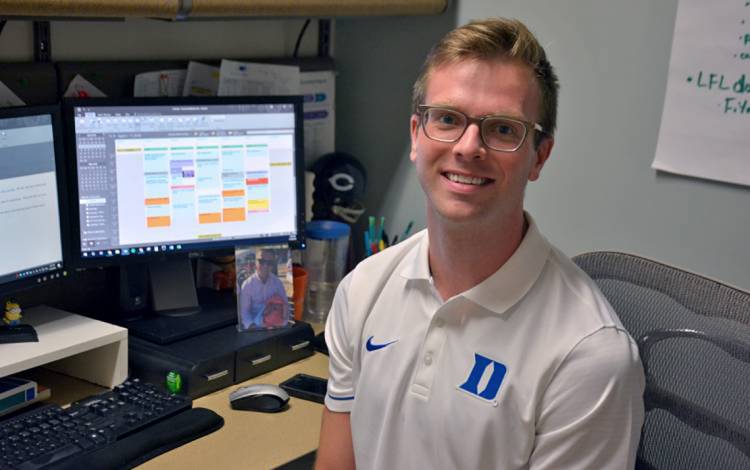Meet Duke’s COVID-19 Lead Contact Tracers
The staff and faculty wellness program strives to stay a step ahead of the virus on campus

On Julie Harris’ first day as a lead COVID-19 contact tracer in July 2020, one sentence uttered by Dr. Carol Epling, director of Employee Occupational Health and Wellness, has stuck with her in the time since.
For Harris, Epling’s reassuring words were a window into the teamwork involved with staying on the trail of coronavirus among Duke’s workforce.
“I remember Dr. Epling saying, ‘This is a great group to be a part of,” Harris said. “It’s because of the wonderful people that we work with; it’s a great team.”
Redeployed from their regular health and fitness programming duties in LIVE FOR LIFE, Duke’s employee wellness program, five lead virus contact tracers — Jessica Bailey, Brandon Harper, Harris, Carlos Velasquez and Tim Bisantz — stay a step ahead of the virus on campus. When an employee tests positive for COVID-19, contact tracing begins, and the lead tracers work alongside a team of about 50 campus contact tracers.
The lead contact tracers assign positive cases to a contact tracer, who opens an investigation into the symptoms of that employee and their activities over the previous 10 days. This helps to determine if other employees may have been exposed to the virus. 
Since the LIVE FOR LIFE team became involved in contact tracing in May 2020, the team has handled tracing positive cases among faculty and staff. Tracing a case could mean contacting as many as 90 people who may have been exposed to the virus to connect them with symptom monitoring and testing.
“If you can stop a case from spreading, you’re potentially keeping employees safe, their family safe, patients safe,” said Julie Joyner, senior contact manager. “Literally, it could save a life.”
Meet Duke’s lead contact tracers:
Julie Harris
Tobacco Free Initiative Program Coordinator
Before COVID-19, Julie Harris was the program coordinator for the Tobacco Free Initiative at Duke.
Duke became a tobacco-free campus on July 1, 2020. By July 6, Harris was redeployed to the contact tracing efforts, with tasks that departed starkly from what she ever envisioned doing in her Duke career.
“Never in a million years did I imagine that my job would be working with a team during a global pandemic and helping Duke employees,” Harris said. “And I wouldn’t trade it for anything. Our whole team, from the other lead tracers and the leadership and the contact tracers, I’ve been in awe of their commitment.”
A health education specialist for LIVE FOR LIFE, Harris works two 12-hour shifts as a contact tracer each week, finding value as a resource to the contact tracing team. It is emotionally difficult sharing news of a positive test result, so Harris boosts the confidence of contact tracers by talking over decisions with them and encouraging the tracers before they make calls to employees who have tested positive.
As a self-described optimist, Harris has learned how to take better care of herself, taking breaks to exercise amid long days. But what keeps her going is the support among team members.
"Sometimes, there's some really hard days when you talk to an employee who is has a very difficult situation and you get off the phone and I cry because it's just an unfortunate really heavy situation,” Harris said. “We like to phone a friend, and you can call one of the leads or the other lead tracer or whomever and just have a conversation and your spirits can be lifted.”
Jessica Bailey
Nurse Manager
The best part of lead contact tracing for Jessica Bailey is interacting with others. Bailey talks with her colleagues on the contact tracing team daily, including weekends.
This comradery has developed a close-knit community and turned relationships with coworkers into more like friends and family.
“We somehow got super lucky and got a good group of staff and we all have wonderful strengths and have been able to put that all together to help employees every day,” Bailey said.
With a background as nurse manager for LIVE FOR LIFE, Bailey is used to the long 12-hour shifts that are typical for nurses. Even though reactions from people who get a call that they may have been exposed to the virus are not always positive, she feels fulfilled.
“Looking at the end of the day and knowing that you have touched a minimum of 150 employees and helped them in some capacity is just amazing,” Bailey said. “Everyday there’s one or more things that happens that I’m just like, ‘wow.’”
Brandon Harper
Health Promotions Manager
Brandon Harper calls himself a “true Dukie to the heart.” He attended Duke as an undergraduate and played offensive guard for the Blue Devils from 2006 to 2010. Now, after returning to his alma mater in 2020, he plays a role on a different kind of team.
“Being able to contribute to the Duke community for me is very important,” Harper said. “Some days are tough, some days are long, but we have a great team.”
Hired in June 2020 as the health promotions manager for LIVE FOR LIFE, Harper hit the ground running in contact tracing. Instead of managing programming for the Get Moving Challenge, Duke Run/Walk Club and Duke Farmers Market, he made phone calls to employees and coached them in next steps after their positive test.
Today, Harper works one to three days each week as lead tracer, supporting the full and part time contact tracers who collect data about positive cases. The rest of the week, he has resumed activities with limited programming, like the virtual Run/Walk Club.
He sees his role in contact tracing, among the larger team, as working to make a difference wherever he can.
“Even if our impacts are short, they’re still meaningful,” Harper said.
Carlos Velasquez
Lead Contact Tracer
Carlos Velasquez starts his lead tracing shift as early as 5 a.m. by reading through hundreds of emails that may have come in from the previous day. He tries to have all cases from the previous shift assigned to case tracers by 6:30 a.m.
Velasquez joined Duke in July 2020 as a lead contact tracer, and he has a background as a public health educator. Even in COVID-19, Velasquez sees himself doing what he’s always wanted to do — educating the community about how to stay healthy.
“My passion has always been to just keep the community around me safe,” Velasquez said. “Whether that is educating them regarding the dangers of diabetes or hypertension or any other health condition they might have, all the way to being the person that manages their education regarding COVID exposures.”
Tim Bisantz
Fitness Program Manager
Working part of his week as the fitness programming manager for LIVE FOR LIFE, Tim Bisantz follows “the classroom method” to stay active while he works on the lead contact tracing team. It’s a schedule similar to a college class.
“For every 50 to 55 minutes,” he explained, “I try to take five minutes for time to get up and moving around.”
With family members who work at hospitals outside of North Carolina, Bisantz understands the efforts devoted at Duke to tracing cases is an example of excellence in patient care, and he is grateful to play a role in helping keep others safe from the virus.
As COVID-19 data and trends change, being on the front line has allowed him to stay on the cutting edge of how vaccine rollouts or booster shots affect contact tracing protocols.
“Duke is a microcosm of the U.S. as a whole,” Bisantz said. “Realizing it’s a hospital system, there are different demographics, different types of people, but you get the best resources available to hear ahead of time what’s going on or what to expect.”
Send story ideas, shout-outs and photographs through our story idea form or write working@duke.edu.